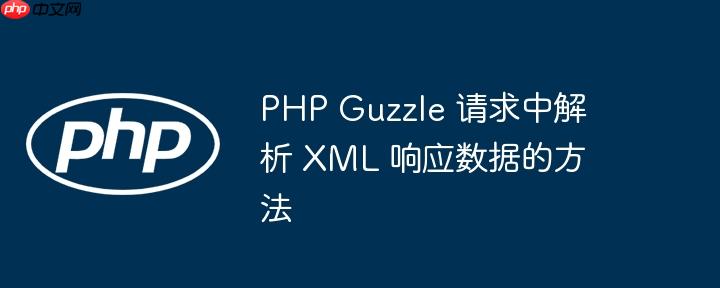
本文介绍了如何使用 PHP Guzzle 库发送 HTTP 请求并解析 XML 响应数据。重点讲解了如何处理带有命名空间的 XML 数据,并提供示例代码演示如何提取 XML 中的特定字段,例如 ID 和 NAME,最终将数据转换为 key => value 数组形式。
在使用 PHP Guzzle 库进行 API 请求时,经常会遇到返回 XML 格式的数据。如果 XML 数据包含命名空间,解析起来可能会比较棘手。本教程将演示如何使用 SimpleXMLElement 类来解析带有命名空间的 XML 数据,并提取所需的信息。
使用 Guzzle 发送请求并获取 XML 响应
首先,我们需要使用 Guzzle 库发送 HTTP 请求,并获取 XML 响应。以下是示例代码:
立即学习“PHP免费学习笔记(深入)”;
<?php
require 'vendor/autoload.php'; // 引入 Guzzle 库
use GuzzleHttp\Client;
$api_url = 'http://example.com/test.asmx/GetUserDetails?userID=123';
$client = new Client();
$response = $client->request('GET', $api_url);
$xml_string = $response->getBody()->getContents();
echo $xml_string; // 输出 XML 字符串
?>确保已经通过 Composer 安装了 Guzzle 库:composer require guzzlehttp/guzzle。
使用 SimpleXMLElement 解析 XML 数据
接下来,我们将使用 SimpleXMLElement 类来解析 XML 数据。如果 XML 数据包含命名空间,我们需要特别注意。
<?php
$xml = new SimpleXMLElement($xml_string);
// 处理命名空间
$diffgr = $xml->children('diffgr', true);
$new_dataset = $diffgr->diffgram->NewDataSet;
$table = $new_dataset->Table;
// 提取数据
$id = (string) $table->ID;
$name = (string) $table->NAME;
// 构建 key => value 数组
$data = [
'ID' => $id,
'NAME' => $name,
];
print_r($data); // 输出结果数组
?>代码解释:
注意事项:
完整示例代码:
<?php
require 'vendor/autoload.php';
use GuzzleHttp\Client;
$api_url = 'http://example.com/test.asmx/GetUserDetails?userID=123'; // 替换为你的 API URL
$client = new Client();
$response = $client->request('GET', $api_url);
$xml_string = $response->getBody()->getContents();
// 示例 XML 数据 (替换为你的实际 XML 数据)
$xml_string = '<?xml version="1.0" encoding="utf-8"?>
<DataSet xmlns="http://example.com">
<xs:schema id="NewDataSet" xmlns="" xmlns:xs="http://www.w3.org/2001/XMLSchema" xmlns:msdata="urn:schemas-microsoft-com:xml-msdata" xmlns:msprop="urn:schemas-microsoft-com:xml-msprop">
<xs:element name="NewDataSet" msdata:IsDataSet="true" msdata:UseCurrentLocale="true">
<xs:complexType>
<xs:choice minOccurs="0" maxOccurs="unbounded">
<xs:element name="Table">
<xs:complexType>
<xs:sequence>
<xs:element name="ID" type="xs:string" minOccurs="0" />
<xs:element name="NAME" type="xs:string" minOccurs="0" />
</xs:sequence>
</xs:complexType>
</xs:element>
</xs:choice>
</xs:complexType>
</xs:element>
</xs:schema>
<diffgr:diffgram xmlns:msdata="urn:schemas-microsoft-com:xml-msdata" xmlns:diffgr="urn:schemas-microsoft-com:xml-diffgram-v1">
<NewDataSet xmlns="">
<Table diffgr:id="Table1" msdata:rowOrder="0">
<ID>123</ID>
<NAME>EXAMPLE</NAME>
</Table>
</NewDataSet>
</diffgr:diffgram>
</DataSet>';
$xml = new SimpleXMLElement($xml_string);
// 处理命名空间
$diffgr = $xml->children('diffgr', true);
$new_dataset = $diffgr->diffgram->NewDataSet;
$table = $new_dataset->Table;
// 提取数据
$id = (string) $table->ID;
$name = (string) $table->NAME;
// 构建 key => value 数组
$data = [
'ID' => $id,
'NAME' => $name,
];
print_r($data);
?>总结
通过本教程,你学习了如何使用 PHP Guzzle 库发送 HTTP 请求,并使用 SimpleXMLElement 类解析带有命名空间的 XML 响应数据。掌握了处理命名空间的关键步骤,并学会了如何提取 XML 中的特定字段,最终将数据转换为 key => value 数组形式。希望本教程能够帮助你更好地处理 XML 数据,提高开发效率。
以上就是PHP Guzzle 请求中解析 XML 响应数据的方法的详细内容,更多请关注php中文网其它相关文章!

PHP怎么学习?PHP怎么入门?PHP在哪学?PHP怎么学才快?不用担心,这里为大家提供了PHP速学教程(入门到精通),有需要的小伙伴保存下载就能学习啦!




Copyright 2014-2025 https://www.php.cn/ All Rights Reserved | php.cn | 湘ICP备2023035733号